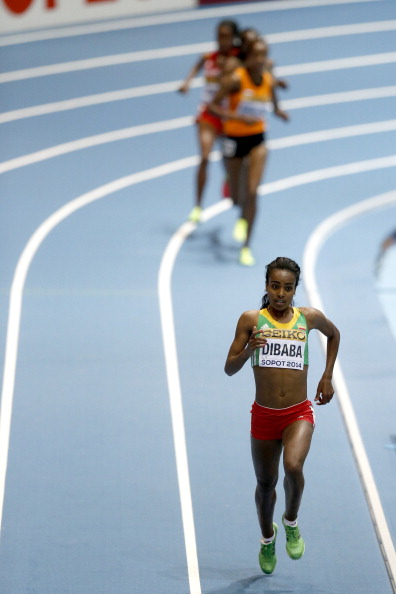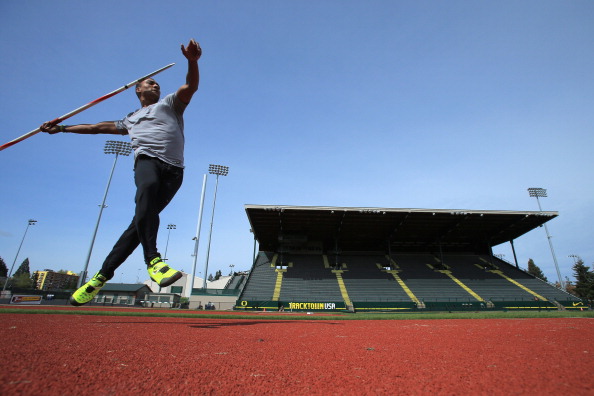SOPOT, Poland — From the bang of the first gun Friday, it was crystal-clear Ashton Eaton is truly one of the most remarkable and versatile athletes of our time. On the track, he seemingly does everything so well. Why doesn’t he get more due?
Running in Lane 8 in the 60-meter dash, Eaton got off to a quick start and, outlined in Team USA red against the blue track, an even-faster finish. He crossed in 6.66 seconds, equaling a personal best.
Eaton is of course the 2012 Olympic decathlon champ. He is, too, the decathlon world-record holder. The heptathlon, the indoor version, offers seven events instead of 10. Eaton’s last three heptathlons have produced world records as well — at the last world indoors, in Istanbul in 2012, he racked up 6,645 points.

To watch Eaton Friday — and, for that matter, the Ethiopian middle distance runner Genzebe Dibaba — is to bear witness to athletic greatness.
Track and field is lucky to have them both.
It is lucky to have anyone, frankly, not named Bolt because the sport cannot be all Usain all the time. Since 2008, when the record-breaking rampage in the sprints began, if most casual fans were asked to name just one track and field athlete the answer would, of course, be Bolt.
Generally speaking, an overarching question for track and field this weekend is easy to frame. These Sopot indoor world championships, as IAAF president Lamine Diack noted at a news conference Thursday, make for the biggest meet of the year, with some 600 athletes from roughly 140 nations. There will be a first edition of the world relays — in the Bahamas in May — but there are no outdoor world championships in 2014.
Bolt is not here in Sopot. He does not do the indoors.
For track fans, as Diack noted, these indoors are indeed a big deal. For everyone else?
The situation is further complicated when the likes of American Nick Symmonds, a silver medalist in the 800 at the 2013 Moscow worlds — he of the new Brooks shoe contract, he of the book due out in June — announces after failing Friday to qualify for the 800 finals that he is done, forever, running indoors.
“It’s a season to have fun and try different things,” Symmonds, always candid, said, adding, “There’s one championship, I want to be out there, I want to give my sponsor the best exposure I can,” and here he waved his shoes at the camera, “so here I am, having a good time even though I’m not in the finals.”
With Dibaba, the major challenge for the sport is she does not speak English — at a time when English is increasingly the global language. Eaton, if he were seemingly anywhere but Oregon, could go to the mall unpestered. Good for him. Bad for track.
First, Dibaba.
Her running style is elegant. Moreover, she comes from running royalty. Her older sister, Tirunesh, has five Olympic distance-event running medals, three gold; another sister, Ejegayehu, is the 2004 Athens 10k silver medalist; a cousin, Derartu Tulu, is the 1992 and 2000 10k gold medalist.
Genzebe Dibaba won the 1500 in Istanbul. In London, a hamstring injury took her out. At the 2013 Moscow world championships, she finished — surprisingly — eighth in the 1500.
This winter, she has simply been on a tear.
Within two weeks in early February, she set two world records — 3:55.17 in the 1500 and 8:16.6 in the 3k. For good measure, she also ran a two-mile world best, 9:00.48.
Here, because this is only a three-day meet, she said she had to choose between the 1500 and the 3k. She opted for the 3k, and in Friday’s heat made it look too easy, running away from the field in 8:57.86.
In the heats, they typically don’t run any faster than they need to — yes, that was indeed 40 seconds slower than that new world record.
She said afterward, “The race went very well. I didn’t want to lead in the early laps. I only wanted to move up with five laps remaining, and I executed my plan. I know I have a great time in this event, and it gives me great confidence.
The Kenyan running in the second heat is the one I have to watch out for,” she said, referring to Hellen Onsando Obiri, who finished behind Maryam Yusuf Jamal of Bahrain in a much-faster heat. Jamal, moving up for the first time from the 1500, finished in 8:53.07, Obiri, the reigning Kenyan champion, in 8:53.31.
“My goal is to win,” Dibaba said. “I don’t think I’ll have a hard time taking gold, God willing.”
Eaton’s elemental goal is to win, too.
In seemingly every way, Eaton comes off as the perfect package. He is not only an athletic talent, he is handsome, well-spoken and humble. And he is now one-half of track’s power couple, married to Canadian Brianne Theisen. Last summer, when he won gold in the decathlon at the world championships, she won silver in the heptathlon; they train together in Eugene, Ore., under coach Harry Mara.
At a news conference here, Eaton had said, “My coach will definitely be the most tired tomorrow. This is the first time [Brianne and I] have done a world indoor championships together. This will be the first time we’ve competed [in the combined events] at the same meet in such close proximity.
“So when I’m doing the long jump, she’ll be doing shot put; we’ll be 20 meters away. It’ll be fun to kind of look over and cheer her on and see how she’s doing and also get some encouragement. We do practice together and it’ll increase our performances being able to feed off each other.”
The pentathlon is a one-day event. Theisen Eaton, with 4768 points, a Canadian record, finished a close second Friday behind Nadine Boersen of Holland, with 4830.
Just 237 points separated first and eighth in the pentathlon — it was the closest-ever contest at the world indoors.
If the 2013 Moscow heptathlon silver marked a breakthrough, this 2014 Sopot silver served as confirmation that she, too, is a world-class talent.
It also served as evidence of her mental resolve -- the thing that all champions have, and must show under pressure.
Theisen Eaton started off the long jump with two fouls before jumping 6.13 meters, or 20 feet, 1-1 1/2 inches.
After that second foul, she said, he — preparing for the shot put — smiled, clapped his hands and said, “Keep going.”
She added, “That is the exact moment when I looked for kind of comfort because I felt scared. It’s great competing with him.”
She also said, “It’s almost like unfair, because no one else gets that.”
During the 800, her final event, “I knew that he would be right there, [saying], ‘Come on, Bri, pick it up, pick it up.’ I thought, ‘I can’t, it’s hard.’ I could just hear him cheering.”
He said, “I am proud of her. I wish she could have gotten one of those long jumps. But that is the way it goes.”
In the night’s only other final, the men’s shot put, American Ryan Whiting took gold with a toss — on his fourth throw — of 22.05, or 72-4 1/4.
For the first time ever at a world indoors, five guys went over 21 meters. Whiting, however, was the only guy in the pack to go over 22.
In Oregon, as noted, Eaton is something of a rock star.
Elsewhere in the United States? The reality is, Marcus Mariota, the quarterback for the Ducks’ football team, would be better known, and by a lot.
That is the — now seemingly eternal, if not infernal — challenge.
The days when Bob Mathias, Milt Campbell, Bill Toomey, Rafer Johnson, even Bruce Jenner were the man among men — those days are long, long gone.
All Eaton does is relentlessly produce.
The long jump — the heptathlon's second event of seven — seemed to doom any world-record bid. Eaton jumped a season-best 7.78, 25-6 1/4. Again, that was best in the field. But in Istanbul two years ago he jumped 8.16, 26-9 1/4.
Then, though, In the evening session, in the shot put, he crept back toward world-record pace, throwing 14.88, 48-10. In Istanbul, his best had been 14.56, 47-9 1/4.
After three events in Istanbul, Eaton had been at 2823 points. After three in Sopot: 2794. Just 29 off.
In the high jump, he banged out 2.06, or 6-9. In Istanbul, he went 2.03, 6-8.
His overnight score in Istanbul: 3654. In Sopot, after that huge effort in the high jump: 3653.
Andrei Krauchanka of Belarus would clear 2.21, 7-3, the outright best-ever within a heptathlon high jump at a world indoors. That pulled him to 3583 points overnight, 70 back of Eaton.
The hurdles, pole vault and 1000 are set for Saturday.
“That is another thing,” Brianne Theisen Eaton said. “I just want to go to sleep and feel at home, you know. Get ready for him for his next day, bring him dinner so he can just lay in bed and relax.”
“I’ve been running great hurdles this year so try to run great again,” Eaton said. Same in the pole vault. “And if I have to go for a record in the 1000, I’ll do it.”














